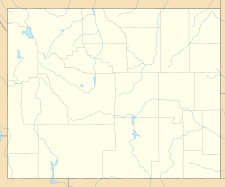Lander Glacier facts for kids
Quick facts for kids Lander Glacier |
|
|---|---|
| Type | Mountain glacier |
| Coordinates | 42°52′02″N 109°19′45″W / 42.86722°N 109.32917°W |
| Area | 55 acres (22 ha) |
| Length | .35 mi (0.56 km) |
| Width | .25 mi (0.40 km) |
| Terminus | Talus |
| Status | Unknown |
Lander Glacier is a fascinating ice formation found in the Wind River Indian Reservation in the U.S. state of Wyoming. It's located about .25 miles (0.40 km) southwest of Mount Lander. This glacier is special because it's not just one big piece of ice. Instead, it's made of three different ice bodies. These icy parts are on the north and west sides of Mount Lander. The largest part flows down from the west side of the mountain. It stretches from about 12,000 feet (3,700 m) down to 11,200 feet (3,400 m) high. This main section is very close to the Continental Divide.
Contents
What is a Glacier?
A glacier is like a giant, slow-moving river of ice. It forms over many years from layers of snow that get packed down. As more snow falls, the weight presses the snow below. This pressure turns the snow into ice. Glaciers are found in places where it's cold enough for snow to stay all year. This means high mountains or very cold polar regions.
How Glaciers Form and Move
Glaciers start as snowflakes. When snow falls and doesn't melt, it builds up. Each new layer of snow pushes down on the layers below. This squeezing action turns the fluffy snow into hard, dense ice. Over hundreds or thousands of years, this ice becomes very thick.
Once a glacier is thick enough, gravity starts to pull it downhill. Even though ice seems solid, it can flow very slowly. This movement is what shapes valleys and mountains over long periods. Glaciers can pick up rocks and dirt as they move. They act like giant bulldozers, carving out the landscape.
Where is Lander Glacier Located?
Lander Glacier is in a beautiful and important area of Wyoming. It's part of the Wind River Indian Reservation. This reservation is home to the Eastern Shoshone and Northern Arapaho tribes. The glacier sits in the Wind River Range, a tall mountain range in the Rocky Mountains.
The Continental Divide
One interesting fact about Lander Glacier is its closeness to the Continental Divide. The Continental Divide is like a giant imaginary line that runs through the Americas. It separates the continent into two main drainage areas. Rain and snow that fall on one side flow towards the Pacific Ocean. Water on the other side flows towards the Atlantic Ocean or the Arctic Ocean. Lander Glacier is just east of this important natural boundary.
Why are Glaciers Important?
Glaciers are more than just big chunks of ice. They play a vital role in our planet's environment.
Water Supply
Many communities around the world rely on glaciers for their water. As glaciers slowly melt during warmer months, they release fresh water. This water fills rivers and lakes. It provides drinking water and water for farming. Without glaciers, many areas would face severe water shortages.
Climate Clues
Glaciers also act like natural history books. The ice layers contain tiny bubbles of air and dust from the past. Scientists can study these layers to learn about Earth's climate long ago. This helps us understand how our climate is changing today.
Ecosystems
Glaciers create unique habitats for plants and animals. The cold meltwater supports special types of fish and insects. The areas around glaciers can also be home to unique plants that thrive in cold, rocky environments.
The Future of Glaciers
Many glaciers around the world are shrinking. This is due to changes in Earth's climate. Warmer temperatures cause glaciers to melt faster than new snow can build up. When glaciers melt, it can affect water supplies and sea levels. Scientists continue to study glaciers like Lander Glacier to understand these changes better. Protecting these natural wonders is important for our planet's future.


